“In Richter’s work there is a demonstration of the ways in which painting’s resources are constantly replenished by the very problems it seems to pose, both for the painter and the viewer. Nobody in our own time has posed them better or solved them more inventively than Richter.” i
— Glenn D. LowryEver since the concept of a hierarchy of art genres was established by the great European Academies in the 16th century wake of the Italian Renaissance, a line of masters have been celebrated as the most distinguished and defining of their successive eras. From da Vinci and Raphael, to Michelangelo, Rembrandt, Turner, Picasso, Monet, and Rothko - only few have succeeded in leaving behind legacies so influential, they have revolutionised the course of art history. With an astoundingly vast and versatile body of work that spans over half a century, from which around forty per cent is now housed in museum collections across the world, Gerhard Richter is, without a doubt, one of the greatest artists of our time.
Firmly placed within the very highest tier of his most prized series, Abstraktes Bild (940-7) stands as the ultimate culmination to the epic journey of Richter’s career-long investigation into the formal possibilities of painting – one of the most extensive enquiries into the bounds of painterly abstraction to have ever occurred. A veritable feast for the senses, its captivating compositional dynamism is both strikingly seductive and sensitive, engulfing viewers in meditative depths of pigment that ricochet across the layered canvas surface in an infinite game of hide-and-seek. Though remarkable even upon first glance, the shimmering canvas fully reveals itself through prolonged contemplation, its astounding topography calling upon us to delve into an archaeological exploration of sorts as we trace each new sweeping accretion of paint that introduces new colour and textural juxtaposition to the work’s architecture.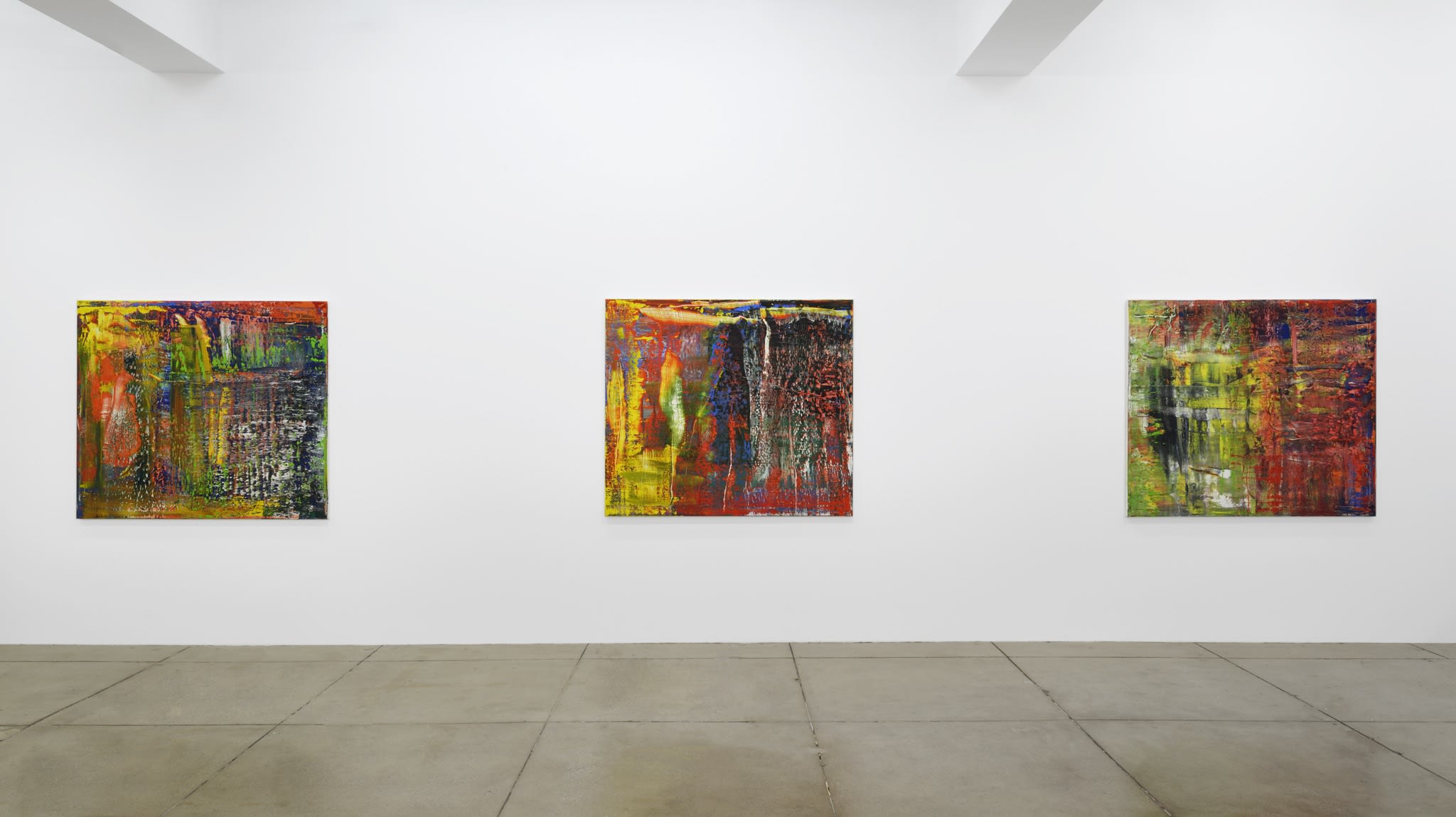
The present work exhibited during New York, Marian Goodman Gallery, Gerhard Richter: Paintings and Drawings, 7 May – 25 June 2016
Painted in 2015 and unveiled at the artist’s 2016 solo exhibition in New York at the gallery of his long-term friend and mentor, Marian Goodman, Abstraktes Bild (940-7) is the last and most authorative of the seven-part series of Abstrakte Bilder paintings numbered 940 in the Richter’s Catalogue Raisonné. Delivering a tonal vivacity of kaleidoscopic primary colour reminiscent of Richter’s most celebrated breakthrough of Abstrakte Bilder works from 1976 and 1977, the present painting marks a distinct departure from an extended period of predominantly more muted, earthy-toned compositions.
Caught within the perimeters of this mature, confident painting – one of the three largest oil on canvas works created this millennium by Richter to have been offered at auction – we can trace every phase of his artistic transformation that, over the past sixty years, has now developed into its most sophisticated stage. At the same time, however, as praised by critic Harvey Brock who notes of Richter’s 2015 paintings: ‘the surfaces of the oil paintings are more active than ever, with patches and lines of scraped canvas standing out like livid scars, and betray a compelling need—an old man’s impatience, perhaps—to get to the point’ii, Abstraktes Bild (940-7) perfectly exemplifies the artist’s masterful ability to, decades on from its conception, surge the series forth to new directions.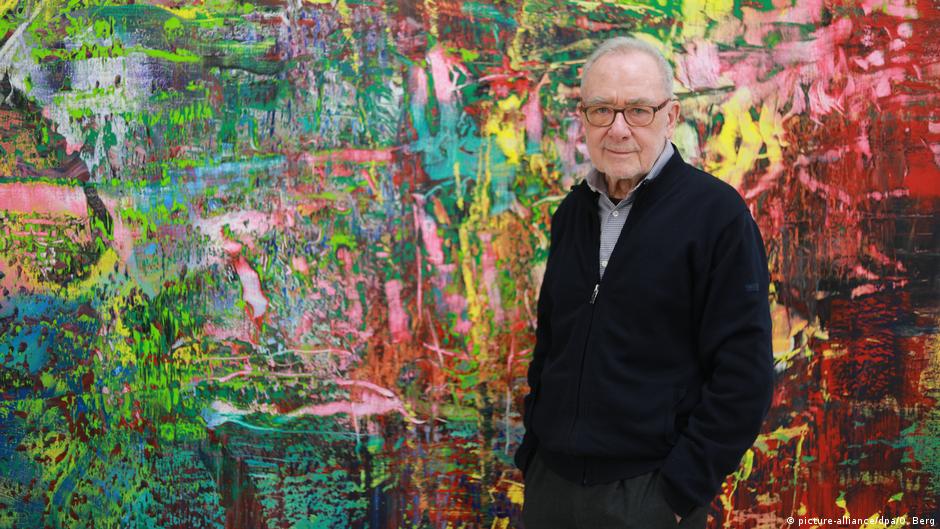
Gerhard Richter, 2016Richter’s Journey to Abstraction
Born in Dresden in 1932, Richter’s ceaseless explorations into the limits of representation and nature of perception derives, in part, from his personal experiences of modern Germany’s tumultuous history. Whilst his mother was a secondary school teacher, she was also a keen pianist and encouraged Richter’s creativity from a young age. His artistic career formally started, however, at the Academy of Fine Arts in the city where between 1951-1956, Richter trained as a muralist before fleeing for West Germany via West Berlin five years later to study at the State Art Academy in Dusseldorf. In his final year he received a major commission for a mural at a Museum in Dresden, garnering him widespread recognition as he came to be considered as one of the most sought-after muralists in the country.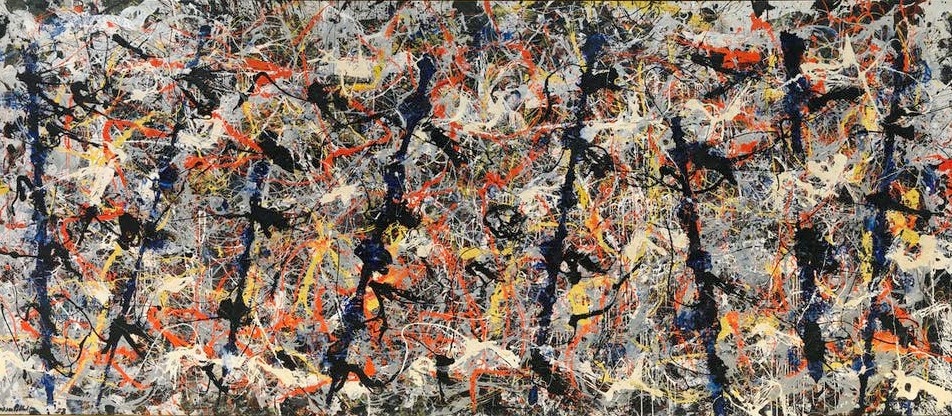
Jackson Pollock, Blue Poles, 1952
Collection of the National Gallery of Australia, Canberra
Though he was already familiar with international art through books and his occasional excursions West, his trip to Documenta II, Kassel, in 1959, marked a significant turning point in Richter’s artistic development. Inspired by the ‘sheer brazenness’iii of works he encountered by Lucio Fontana and Jackson Pollock, Richter began working in a more uninhibited avant-garde manner, experimenting with a variety of innovative techniques, concentrating on the chance details that emerge from the process of painting. Three years later, in 1962, Richter created Tisch (Table), the first work to be numbered in the index of works compiled by the artist himself, indicating a new beginning for his art.
As the first Abstrakte Bilder canvas Richter has created in the past eleven years to be offered at auction, the present work is an exquisite, mature summation of Richter’s legendary series. Its tactile surface can be endlessly explored, and, in doing so, we come to recognise how the perfect balances caught between chance and decision, and sharp and soft, are the result of each new area of experimentation that have ultimately shaped the trajectory of his renowned oeuvre.Tracing Richter's Oeuvre
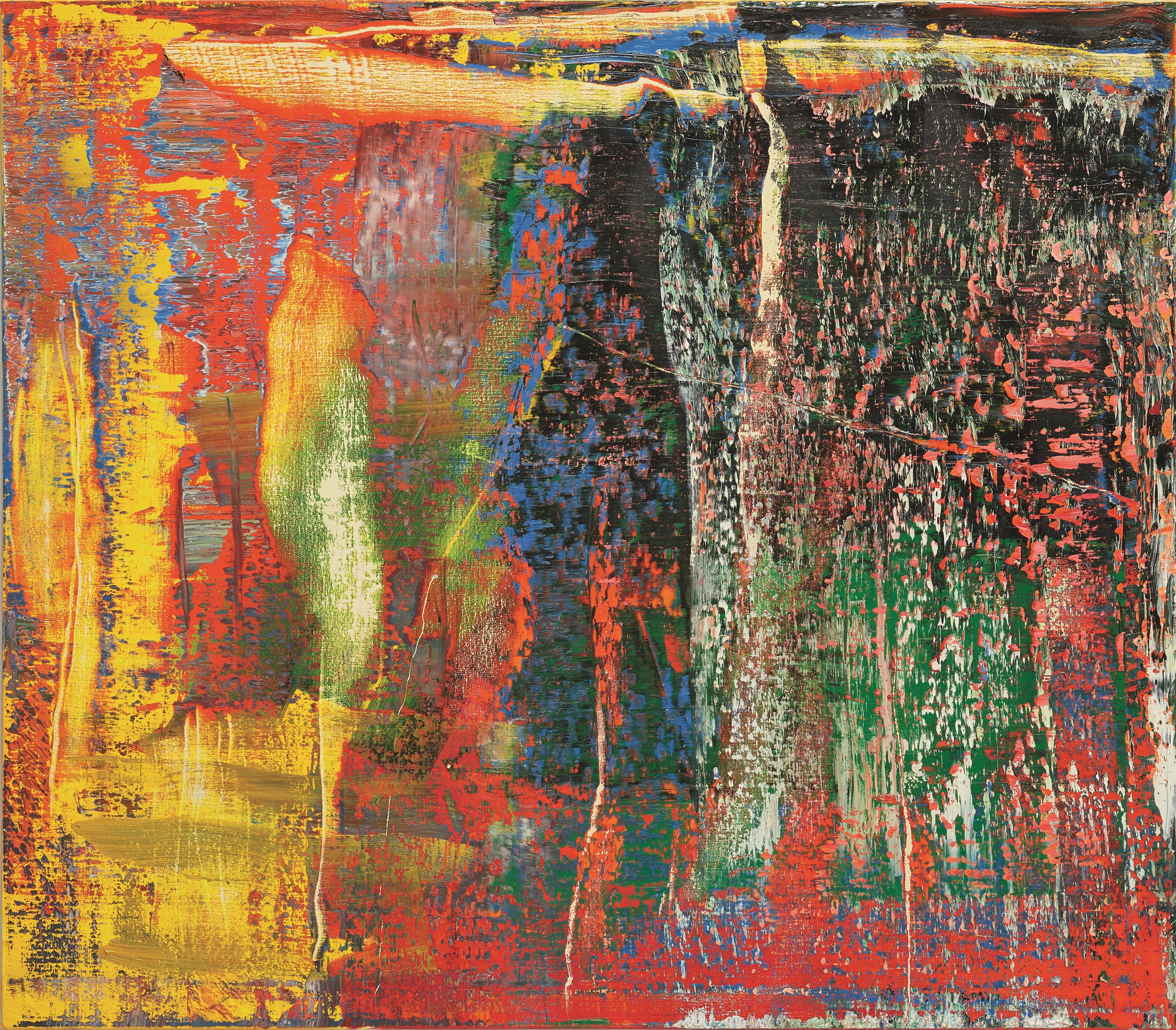
Abstraktes Bild (940-7), 2015
In 2014, after his 4-part Birkenau series, we see within Richter’s Abstrakte Bilder works an almost reinvigorated sense of energy as he returns to the vibrant colour palette that characterised his early Abstrakte Bilder pieces. In the period of paintings that followed, of which this present work forms part of, Richter moves away from his use of more toned-down colours, instead selecting shades from all ends of the colour spectrum that both complement and challenge each other within the same pictorial space.
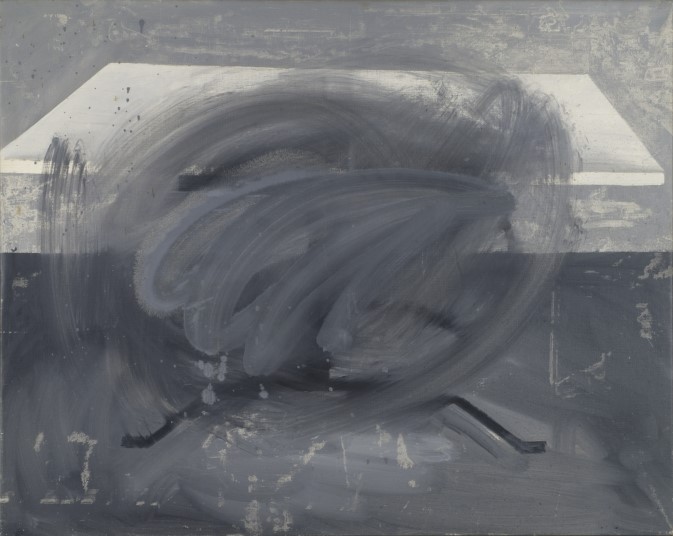
Tisch (Table), 1962
Collection of the Busch-Reisinger Museum, Harvard Art Museums, Massachusetts (on loan from Private Collection)A photorealistic painting of a table overlaid by disrupted paint, Tisch marks the beginning of Richter’s career-long preoccupation with blurring the distinction between abstraction and figuration, considered by the artist to be his first mature work.
Based on a black and white illustration of a table taken from the Italian magazine Domus, Richter was unhappy with his representation and thus re-worked the canvas by wiping solvent—either turpentine of benzene—directly onto the work in a circular motion outwards from the centre. In doing so, the solvent lifted the pigment and moved it around, obliterating the image into a neutral haze as the figurative ground is overcast by Richter’s abstract gesture.
Exploring personal engagement versus objective neutrality, planning versus chance, and mark-making versus erasure, the painting embodies a certain set of tensions that we distinctly see develop throughout his oeuvre across the various series that would come to follow.
“I was dissatisfied because there was too much paint on the canvas and became less happy with it, so I overpainted it. Then suddenly it acquired a quality which appealed to me and I felt it should be left that way, without knowing why.” iv — Gerhard Richter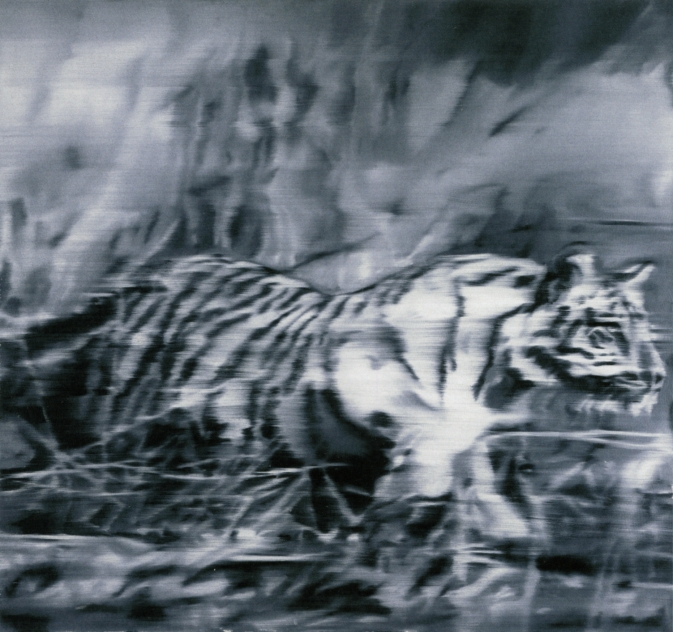
Tiger, 1965
Museum Morsbroich, Leverkusen, GermanyRichter continued his experimentations with using ready-made photographs as the basis for paintings, working both from found material and his own personal archive.
Rendering the painted photographs with an extraordinary sensitivity and softly blurred focus, he brings into question the discrepancies between reality itself and how this reality is portrayed. As a central motif to his practice, we see the stylistic devices of photography – accuracy, blurring and illusionism – throughout the development of his abstract visual formulae.
“Illusion – or rather appearance, semblance – is the theme of my life.” v — Gerhard Richter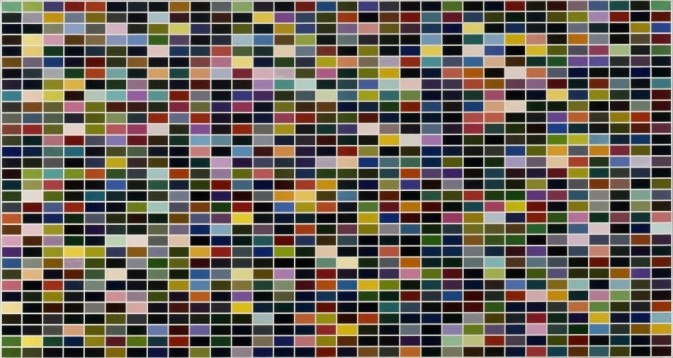
Gerhard Richter, 1024 Farben (1024 Colours), 1973
Collection of the Musée National d'Art Moderne, Centre Georges Pompidou, ParisBetween the years 1968 and 1976, Richter expanded his stylistic range, experimenting with and refining numerous modes of painting. Importantly, in 1966 he began his Colour Chart paintings. In Richter’s Colour Chart works, based on sample cards from a paint store, colours are presented as ready-mades without any expressive value or symbolism. Each colour was selected at random by drawing lots, indicating the first time Richter suggested using the principle of coincidence. Identical in form and size, the coloured rectangles are arranged orthogonally across the entire surface, each laying claim to a specific area of space that when combined, establishes a regular grid structure. As such, drawing a distinct link to the present painting and other Abstrakte Bilder pieces, we can imagine a possible continuation of the gridded colour chart structure beyond the work’s edges. Moreover, with colours distributed irregularly across the entire surface, a visual complexity is introduced that exceeds the eye’s ability to adapt, just as in the overlapping paint in the present work.
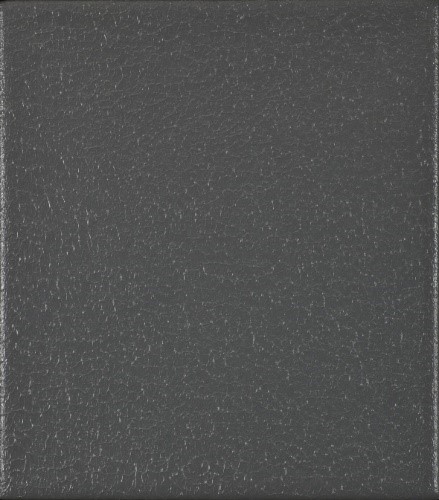
Grau (Gray), 1975
Collection of The Olbricht Collection, EssenThough Richter had already begun his experimentations with monochromatic grey paintings in the 1960s, he devoted more time to his explorations of this theme into the 1970s. Modulated only by the manner in which paint was applied, the grey monochromes portray different textures that cover the surface of each work, concluding with his Grau works of 1976 which are the most texturally subtle. Richter was attracted to the neutrality and inconspicuousness of the tonal shade, and although the monochrome treatment differs greatly from the present work’s vibrant formulation, the grey monochromes distinctly share the visual aesthetic of texture traversing the whole composition, offering no indication as to which mark met the canvas first.
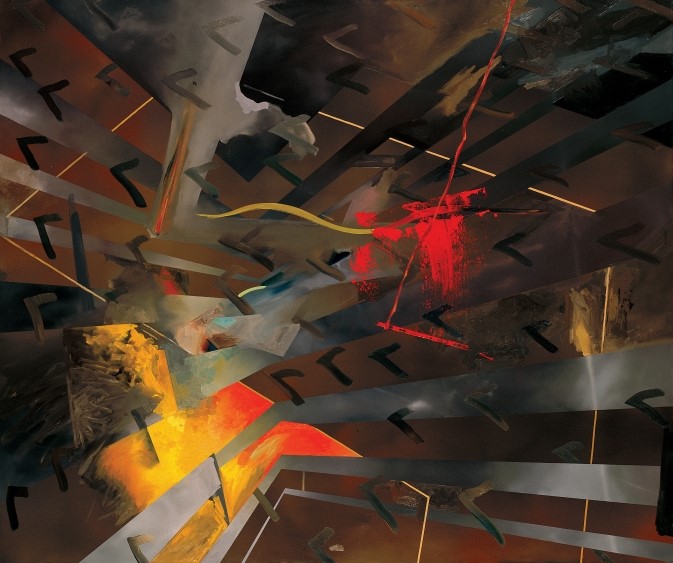
Konstruktion (Construction), 1976
The introduction of Richter’s Abstrakte Bilder paintings from 1976 would come to largely determine his body of work from then on. The abrupt change in style from his grey monochromes both demonstrated his determination to make a new start, but also his renewed self-confidence. His new paintings overwhelmed the viewer with a visual explosion of colour that overlapped in innumerable ways, leading the viewers eyes to wander without coming to rest at any fixed point. It was also around this time, between 1976 and 1987, that Richter’s historical reputation took on a new dynamic as a network of galleries launched a series of more prolific exhibitions, both nationally and internationally.
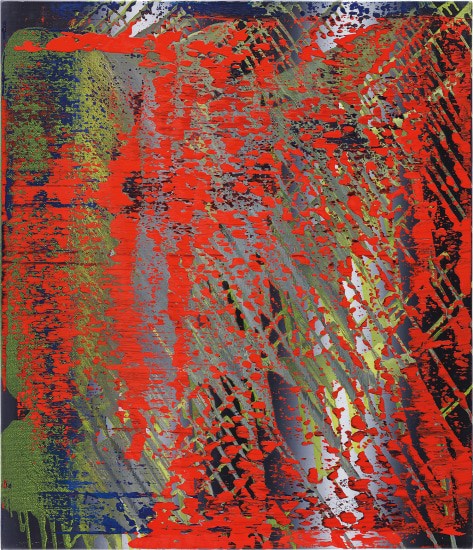
Abstraktes Bild (682-4), 1988
72.5 x 62.2 cm. (28 1/2 x 24 1/2 in.)
Sold by Phillips, Hong Kong, 3 December 2020, lot 8
Estimate HK$20,000,000 - 30,000,000 / Sold For HK$32,315,000By the mid-1980s, Richter was using his ground-breaking squeegee tool which introduced a higher degree of coincidence to the painting process and thus, a further loss of control. It would become his signature tool from 1986 onwards, as the occasional accent transformed into marks that dominated his colourful works. Rough, multi-layered, complex, and resilient, with no orderly direction, this method allowed Richter to ‘obtain in the end a picture which [he] had not planned at all’ vi. It was during this period that Richter truly achieved worldwide acclaim for his chromatically vivid abstract paintings, such as Abstraktes Bild (682-4), a smaller oil on canvas work which recently surpassed its estimates when it was sold by Phillips Hong Kong in December 2020.
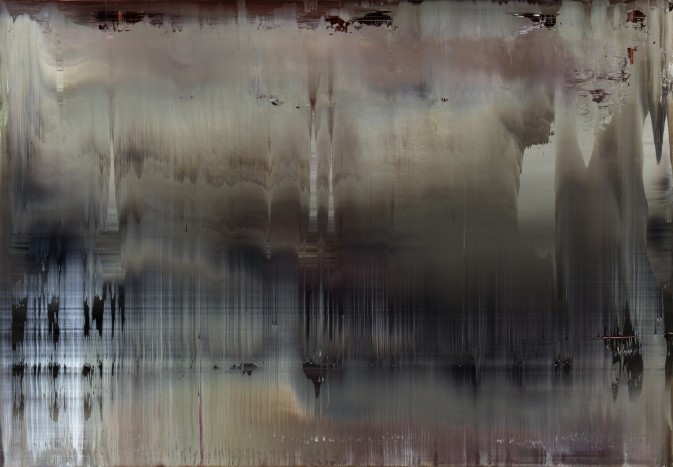
Abstraktes Bild 869-6, 2000
Neues Museum, Staatliches Museum für Kunst und Design, Nuremberg (on loan from Böckmann Collection)Through the 1990s and 2000s, Richter continued to build both his completely abstract works and his works that strike a tense balance between abstraction and figuration, honing his already celebrated abilities over a variety of different styled compositions. His reputation as one of the most influential artists of our era was cemented in a series of major exhibitions held during this period: a 1991 breakthrough retrospective at the Tate Gallery, London; Documenta (IX in 1992, X in 1997); a major touring exhibition of 130 works in 1993; Venice Biennale in 1997 and 2007; retrospectives in the United States in 1998 and 2002; amongst others.
His Abstrakte Bilder paintings become less chromatically vibrant toward the end of 1999, remaining predominately more muted in colour, with earthy tones reminiscent of scenes from nature. This aesthetic carries through to his Birkenau paintings from 2014, a series which powerfully reckons with issues of identity in the context of post-World War II Germany.
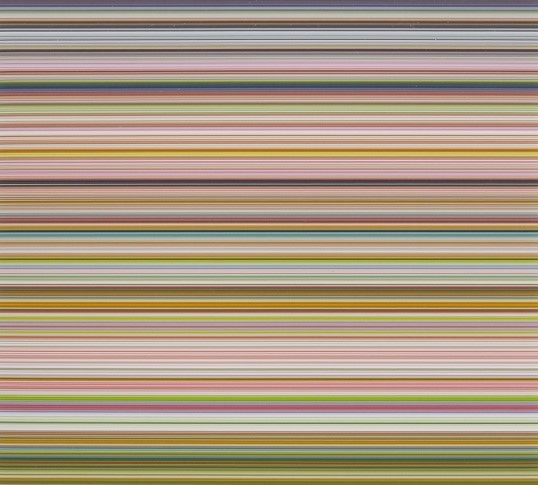
Strip, 2012
Collection of the Kunstmuseum Winterthur, SwitzerlandIn the first half of the 2010s, Richter turned his attention to ‘initiatives directed towards recasting painting… in various ways, in order to return to it in the end.’vii This resulted in a series of paintings behind glass, and his series of Strip abstract works from 2011. Composed of narrow strips of colour arranged horizontally in parallel across the entire plane, the colours are taken from one of his Abstrakte Bilder works. Whilst these too, align with Richter’s Abstrakte Bilder series whereby the undulating dynamic engulfs the viewer, his Strip works were more controlled, created with a more mechanical mode of execution.

Abstraktes Bild (940-7), 2015
In 2014, after his 4-part Birkenau series, we see within Richter’s Abstrakte Bilder works an almost reinvigorated sense of energy as he returns to the vibrant colour palette that characterised his early Abstrakte Bilder pieces. In the period of paintings that followed, of which this present work forms part of, Richter moves away from his use of more toned-down colours, instead selecting shades from all ends of the colour spectrum that both complement and challenge each other within the same pictorial space.

Tisch (Table), 1962
Collection of the Busch-Reisinger Museum, Harvard Art Museums, Massachusetts (on loan from Private Collection)A photorealistic painting of a table overlaid by disrupted paint, Tisch marks the beginning of Richter’s career-long preoccupation with blurring the distinction between abstraction and figuration, considered by the artist to be his first mature work.
Based on a black and white illustration of a table taken from the Italian magazine Domus, Richter was unhappy with his representation and thus re-worked the canvas by wiping solvent—either turpentine of benzene—directly onto the work in a circular motion outwards from the centre. In doing so, the solvent lifted the pigment and moved it around, obliterating the image into a neutral haze as the figurative ground is overcast by Richter’s abstract gesture.
Exploring personal engagement versus objective neutrality, planning versus chance, and mark-making versus erasure, the painting embodies a certain set of tensions that we distinctly see develop throughout his oeuvre across the various series that would come to follow.
“I was dissatisfied because there was too much paint on the canvas and became less happy with it, so I overpainted it. Then suddenly it acquired a quality which appealed to me and I felt it should be left that way, without knowing why.” iv — Gerhard Richter
Abstraktes Bild (940-7)
“Richter’s late abstractions (painted after the Birkenau paintings) seem to have emerged from the doubts whether any painterly practice could still enact a critical resistance to its proper spectacularisation. Facing that condition without cynicism, the seemingly random multiplicity of tints and tones and the compression of arbitrary factures now achieve the perfect pictorial balance between recalcitrance and resistance.” — Benjamin Buchloh
A triumph of his mature period, Abstraktes Bild (940-7) is spectacular both in chromatic and textural complexity, presenting the viewer with lusciously viscous oil paint that cascades across the canvas surface in all directions. The artist’s masterful command of the painterly process comes to the fore in the ridges, crests and peaks of stuttering blue and luminous red impasto that punctuates the softer construction of white, lemon yellow, green and black beneath. In selecting such colours, the waterfall of pigment in Abstraktes Bild (940-7) can be seen as a homage to Richter’s abstract processors Piet Mondrian and Barnett Newman, who too, confronted the historical use of primary colours in their visual vocabulary. However, whereas Mondrian and Newman limited their palette to reduce visual compositions to their most basic forms, the densely packed surface of Abstraktes Bild (940-7) both reflects light and casts shadows, stimulating the senses as we’re drawn into a myriad of focal points buried deep within the rich, harmonious abyss.Piet Mondrian, Composition in Red, Blue, and Yellow, 1937-42
Collection of the Museum of Modern Art, New YorkThough imbued with a dynamic energy that feels to be wholly spontaneous, each sculpted mark is laborious in its execution, and visible across the entire surface of the present work is the remarkable power of Richter’s signature squeegee – a long bladed tool fitted with a wooden handle. After swathes of thick oil paint have been fixed onto the canvas, Richter then steps away, allowing each to dry until a certain extent before adding the subsequent layer on. Then, pulling his far-reaching squeegee across the surface, its edge disrupts the set composition, leaving behind eroded paint in its wake. Although variances in pressure and speed are accounted for, where the paint sticks, ruptures and mixes can only be calculated up to a point, thus producing a manifold of overlapping layers whose actual sequence of application does not necessarily align with the optical impression of background and foreground.
"I want to end up with a picture that I haven’t planned. This method of arbitrary choice, chance, inspiration and destruction may produce a specific type of picture, but it never produces a predetermined picture…I just want to get something more interesting out of it than those things I can think out for myself.” — Gerhard Richter in 1990
Reminiscent of Josef Albers and Johannes Itten’s exploration of spatial effects in colour theory, a visual sense of depth is inherent in every hue in Abstraktes Bild (940-7), strengthened by each shade’s vibrancy as well as which contrasting colours are adjacent. Formed through both choice and accident, the tiered oil pigments work to generate an infinite number of contradictory experiences, allowing for unpredictable results to occur that go beyond both the artist’s and viewer’s expectations. Each painting undergoes a process of metamorphosis before Richter believes an optimal level of harmony has been achieved. Likening the experience to a game of chess, a work is only deemed complete once Richter can ‘enter the room and say, Checkmate.’ viii
Calculated Chance
Although the present work is entirely abstract, in embracing chance in its execution, the slippages and painterly accidents that are beyond the artist’s control introduce an almost organic figuration, bringing to mind rippling water, sand dunes, sunsets, and the unpredictability and destructive formation of nature itself. And whilst contemporary comparisons can be made to artists such as Lucas Arruda, who like Richter, follows a process of building up and removing pigment to create his abstract landscape works (see for example, Lot 12 – Untitled from the series Deserto-Modelo (2012)), in examining the intricately composed surface, it comes as no surprise that Richter’s Abstrakte Bilder series are more commonly compared to the great Impressionist landscapes, such as those painted en plein air by Claude Monet.
Claude Monet, The Japanese Footbridge, circa 1920-22
Collection of the Museum of Modern Art, New York
Capturing the fleeting effects of light to express the sensation of standing within nature itself, the constant motion of Monet’s chosen subjects could not be foreseen. As such, choices in artistic production were left subjective to his cognitive senses at any given moment - a method of working Richter too, has developed in his own studio practice, despite arriving at the same effect through entirely different means.
At the same time, whilst independent from any particular photographic mode, the out-of-focus consistency of the sweeping accretions of impasto in Abstraktes Bild (940-7) draws a direct, contemporary link to photography and in particular, Richter’s blurred Photo Paintings. Indeed, an alternative interpretation of the use of red and green in the present painting calls to mind the RGB colour model used for the representation and display of images in cameras and other electronic systems. Richter has elaborated on this connection, stating: 'Every time we describe an event, add up a column of figures or take a photograph of a tree, we create a model; without models we would know nothing about reality and would be like animals. Abstract paintings are fictitious models because they visualise a reality, which we can neither see nor describe, but which may nevertheless conclude exists. We attach negative names to this reality; the un-known, the un-graspable, the infinite, and for thousands of years we have depicted it in terms of substitute images live heaven and hell, gods and devils. With abstract painting we create a better means of approaching what can be neither seen nor understood' ix.Having claimed he ‘paints like a camera’ even when photographic content is absent from his work, within the field of the abstract canvas, both natural phenomena and photographic exposure are evoked, injecting the piece with an undisputed, timeless brilliance that transcends the genres of the past through Richter’s distinctly contemporary lens.

Detail, Abstraktes Bild (940-7)
Collector’s Digest
One of the most important and prolific artists of our era, Richter has been the recipient of numerous prominent awards, including the State Prize of the state North Rhine-Westphalia in 2000; the Wexner Prize, 1998; the Praemium Imperiale, Japan, 1997; the Golden Lion of the 47th Biennale, Venice, 1997; the Wolf Prize in Israel in 1994/5; the Kaiserring Prize der Stadt Goslar, Mönchehaus-Museum für Moderne Kunst, Goslar, Germany, 1988; the Oskar Kokoschka Prize, Vienna, 1985; the Arnold Bode Prize, Kassel, 1981; and the Junger Western Art Prize, Germany, 1961. He was made an honorary citizen of Cologne in April 2007.Richter has exhibited extensively at prestigious venues throughout the world. Recently, this has included at the Sies + Höke, Düsseldorf (8 February – 2 March 2021), and the comprehensive exhibition Gerhard Richter: Painting After All, held at The Met Breuer, The Metropolitan Museum of Art, New York (4 March – 5 July 2020). A solo exhibition is currently taking place at the Kunsthaus Zürich, running from 26 March – 25 July 2021.
New York, The Metropolitan Museum of Art, Gerhard Richter: Painting After All, 4 March - 5 July 2020
i Glenn D. Lowry quoted in Gerhard Richter: Forty Years of Painting, exh. cat., Museum of Modern Art, New York, 2002, p. 7
ii Hovey Brock, 'ArtSeen: Gerhard Richter', The Brooklyn Rail, July – August 2016, online
iii Gerhard Richter in an interview with Benjamin H.D. Buchloh, 1986, Daily Practice, p. 132
iv Gerhard Richter, quoted in Dietmar Elger, Gerhard Richter: A Life in Painting, Chicago, 2009, p. 48
v Gerhard Richter, 'Notes, 1989', in Gerhard Richter: Writings 1961-2007, New York, 2009, p. 215
vi Gerhard Richter in an interview with Sabine Schütz, 15 January 1990, Journal of Contemporary Art, online
vii Dieter Schwartz, 'Beginning Again: New Abstract Paintings by Gerhard Richter’, in Gerhard Richter: Paintings and Drawings, exh.cat., Marian Goodman Gallery, New York, 2016, n.p.
viii Gerhard Richer, quoted in Michael Kimmelmann, ‘Gerhard Richter: An Artist Beyond Isms’, The New York Times, January 27, 2002, n.p.
ix Gerhard Richter quoted in Gerhard Richter: Painting, exh. cat., Museum of Contemporary Art, Chicago, 1988, p. 107
Provenance
Marian Goodman Gallery, New York
Acquired from the above by the present owner in 2016Exhibited
New York, Marian Goodman Gallery, Gerhard Richter: Paintings and Drawings, 7 May – 25 June 2016
Artist Biography
Gerhard Richter
German • 1932
Powerhouse painter Gerhard Richter has been a key player in defining the formal and ideological agenda for painting in contemporary art. His instantaneously recognizable canvases literally and figuratively blur the lines of representation and abstraction. Uninterested in classification, Richter skates between unorthodoxy and realism, much to the delight of institutions and the market alike.
Richter's color palette of potent hues is all substance and "no style," in the artist's own words. From career start in 1962, Richter developed both his photorealist and abstracted languages side-by-side, producing voraciously and evolving his artistic style in short intervals. Richter's illusory paintings find themselves on the walls of the world's most revered museums—for instance, London’s Tate Modern displays the Cage (1) – (6), 2006 paintings that were named after experimental composer John Cage and that inspired the balletic 'Rambert Event' hosted by Phillips Berkeley Square in 2016.
View More Works
Property from the Collection of Guy Laliberté, founder of Cirque du Soleil
Ο◆✱13
Abstraktes Bild (940-7)
signed, numbered and dated '940-7 Richter 2015' on the reverse
oil on canvas
140 x 160 cm. (55 1/8 x 62 7/8 in.)
Executed in 2015.
Estimate
HK$75,000,000 - 95,000,000
€7,890,000-10,000,000
$9,620,000-12,180,000
Sold for HK$95,100,000
Charlotte Raybaud
Head of Evening Sale, 20th Century & Contemporary Art
CharlotteRaybaud@phillips.com
20th Century & Contemporary Art Evening Sale in Association with Poly Auction
Hong Kong Auction 8 June 2021
9
This lot is no longer available.
30
This lot is no longer available.